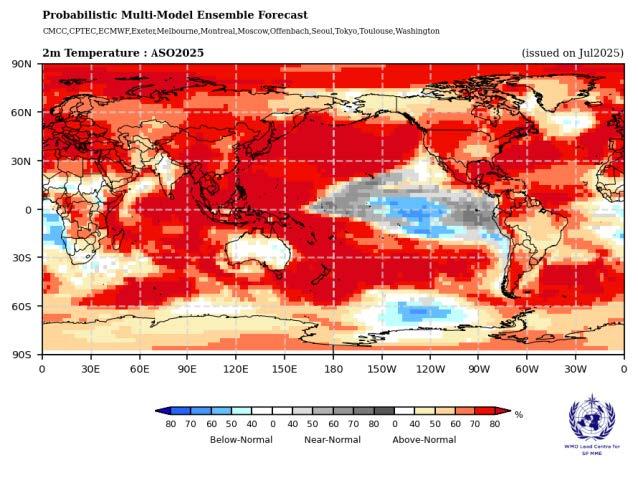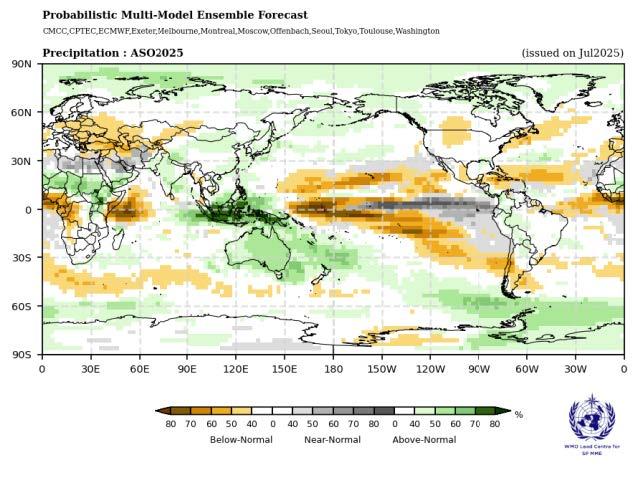Global Seasonal Climate Update for August-September-October 2025
Observed Oceanic Drivers for the Previous Season: During April–June 2025, global ocean sea-surface temperature (SST) anomalies were generally above average, particularly across the extratropical latitudes1. A notable exception occurred in the equatorial central Pacific near the Dateline, where SST anomalies were closer to average. All Pacific Niño indices remained near-average, except for Niño 1+2, which was slightly above normal. The Indian Ocean Dipole (IOD) index was also near average, while SST anomalies in both the North Tropical Atlantic (NTA) and South Tropical Atlantic (STA) hovered close to normal levels.

Outlook for Oceanic Drivers for the Next Season: During August–October 2025, Niño SST indices in the central Pacific are forecast to decline, with a transition toward weak La Niña conditions a possibility. The Indian Ocean Dipole (IOD) index is also projected to weaken and shift into its negative phase. SST anomalies in both the North Tropical Atlantic and South Tropical Atlantic are expected to remain near average, while above-normal SSTs in the extratropical oceans are projected to persist.
Surface Temperature Outlook for the Next Season:
Consistent with projections of sustained above-normal sea-surface temperatures across most ocean basins, excluding portions of the equatorial central and eastern Pacific, above-normal surface temperatures are forecast for the majority of land areas during August–October 2025.
Model agreement is particularly strong across the northern mid-latitudes, including parts of North America, Europe, and northern Asia, where a robust multi-model consensus supports elevated probabilities for warmer-than-normal surface temperature conditions. High model consistency also contributes to enhanced probabilities over northern Africa, the Maritime Continent, northern Australia, New Zealand, and parts of South America—particularly southern regions extending along the western coastal zones northward.
Conversely, model consistency is notably lower over the Indian subcontinent, southern Africa, most of Australia, and eastern South America. In these regions, forecast guidance suggests only modest or localized increases in the likelihood of above-normal temperatures, indicating greater uncertainty and a possible tilt toward near-normal outcomes.
Over the tropical Pacific east of the Dateline, multi-model guidance shows mixed signals, consistent with expectations for neutral ENSO conditions and subdued oceanic temperature anomalies.
Rainfall Outlook for the Next Season:
Seasonal forecast models indicate spatially varied rainfall patterns during August–October 2025, shaped in part by neutral ENSO conditions together with enhanced positive east-to-west sea-surface temperature gradient, reminiscent of weak La Niña conditions.
Enhanced probabilities for above-normal rainfall are projected for Australia, the Maritime Continent, equatorial eastern Africa extending westward along 15°N, and parts of the Indian subcontinent and eastern Asia. These signals are supported by moderate to strong model agreement. Particularly high multi-model consistency is evident over the western equatorial Pacific.
Enhanced probabilities for below-normal rainfall are predicted across eastern Europe, Central America, the Caribbean, equatorial western Africa adjacent to the Gulf of Guinea, and the southern regions of South America. These dry signals correspond to moderate-to-high model consistency.
Over the central and eastern equatorial Pacific, a strongly enhanced probability for below-normal rainfall is predicted near the Date Line, with this dry signal extending south-eastward toward the southern tip of the western coast of South America. East of 160°W along the equator, forecast guidance supports an increased likelihood of near-normal rainfall, consistent with neutral ENSO conditions and weak local sea surface temperature anomalies.


1 https://www.cpc.ncep.noaa.gov/products/people/mchen/AttributionAnalysis…










